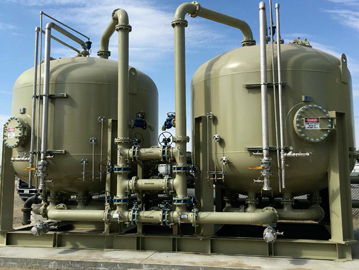Report Sets Path Toward Clean Drinking Water for All Californians
Study co-authored by UCLA researchers finds hundreds of public water systems are out of compliance
Michelle Einstein | April 12, 2021

Wellhead treatment plants like this one play an important role in providing clean water to communities across the state. Courtesy of the California State Water Resources Control Board.
California was the first U.S. state to legally recognize access to safe, clean and affordable water as a human right. But substantial parts of the state lack access to drinking water that meets those criteria.
A new study (PDF) published by the California State Water Board and supported by UCLA research identifies a risk for failure among a significant portion of the state’s small and medium-sized public water systems. The report is the first comprehensive analysis of how clean water is provided in California, and it estimates how much it would actually cost to deliver safe water to every resident.
The research was a collaboration between the UCLA Luskin Center for Innovation, the water board’s Needs Analysis Unit, Corona Environmental Consulting, Sacramento State University’s Office of Water Programs, the Pacific Institute and the University of North Carolina’s Environmental Finance Center.
Of the 2,779 public water systems evaluated in the study, nearly half are at some risk of failing to provide an adequate supply of safe drinking water. To measure the health of water systems, the researchers assessed each water system using 19 indicators for water quality, accessibility, affordability and operational capacity.
Based on those assessments, each system received an overall rating indicating how likely it would be to fail — from “not at risk” at the top end of the scale, to “potentially at risk” and “at risk” for the systems with the lowest scores. The researchers found 25% of water systems to be “at risk,” while an additional 23% are “potentially at risk.”
The study also identified locations where groundwater quality is out of compliance with the state’s safe water drinking standards. About one-third of domestic wells and one-half of state small water systems were found to be at a high risk for containing contaminants like nitrate and arsenic.
“Illuminating the extent of at-risk water systems is an important step,” said Gregory Pierce, the study’s principal investigator and an associate director at the Luskin Center for Innovation. “By more fully understanding the issues, we can move to more resilient and accessible water sources.”
The study noted that water quality and infrastructure issues vary substantially across the state. For instance, Kings County, in central California, has the highest proportion of at-risk public water systems (75%), while San Francisco County and Modoc County in the northern part of the state have zero at-risk systems.
The research incorporated a comprehensive evaluation of thousands of water systems and hundreds of thousands of wells, as well as input from water managers, environmental nonprofits and advocacy groups.
Among the other findings:
Holistic solutions can help.
- In the short term, bottled water and home filtration systems can be used to help communities that need clean drinking water immediately. The researchers estimate that those short-term interventions would cost between $500 million and $1.6 billion over the next five to nine years.
- Long-term solutions include enhancing water treatment; consolidating small, underperforming water systems; and providing experts to advise communities on how to improve those systems. The study estimates a wide range of total costs for those solutions, depending on which actions local systems adopt, but the midpoint estimate is about $5.7 billion.
More funding will be needed.
- The Safe and Affordable Drinking Water Fund, which was established in 2019 to help bring adequate drinking water to disadvantaged communities, already provides critical financial support. But for all California communities to have reliably safe drinking water, more financial resources are likely needed.
- Additional funding could come from a variety of sources, including the state legislature, the governor’s office and federal agencies.
The analysis suggests prioritizing funding for water systems that are currently most at risk and that are located in underserved communities. It also sets the stage for a deeper investigation of how the state can ensure safe, clean and affordable water for all — an especially salient issue as Congress is considering a federal infrastructure bill that would, in part, address the systems that deliver drinking water throughout the U.S.
“I’m optimistic that as a nation, we’re talking about upgrading our pipes and cleaning up our contaminated drinking water,” said Peter Roquemore, a co-author of the study and a researcher at the Luskin Center for Innovation. “Infrastructure might not always be glamorous, but the impacts of fixing our water systems would be huge.”


